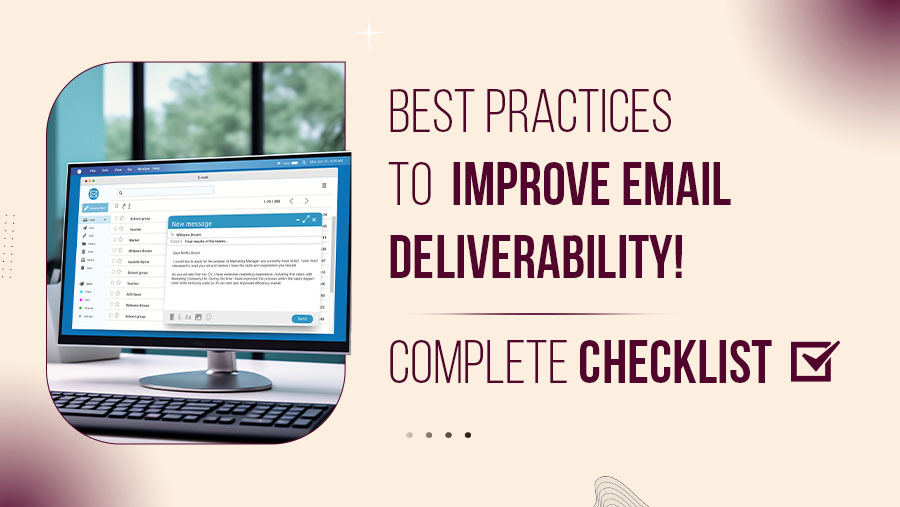
Best Practices to Improve Email Deliverability! Complete Checklist
What if 20% of your emails never made it to anyone’s inbox?
According to Validity’s Email Deliverability Benchmark Report, 83% of marketing emails reach the inbox. That means 1 in 6 emails go undelivered or land in spam.
In a world where cold outreach and nurture campaigns drive revenue, poor email deliverability can silently kill your ROI. You write the perfect subject line. Your CTA is perfect. But if the email never gets seen? Game over.
This comprehensive 27-step email deliverability checklist gives you everything you need to optimize for inbox placement, protect your sender reputation, and run outbound email campaigns that actually get read.
What Is Email Deliverability?
Email deliverability is your ability to deliver email to the inbox — not just “successfully send” it.
- Delivery means your email didn’t bounce.
- Deliverability means your email skipped spam filters and reached the inbox.
Why It Matters:
If your email delivery service shows a 98% delivery rate, that’s great — but if only 70% reach the inbox, you’re leaving thousands of dollars on the table.
These numbers aren’t arbitrary — mailbox providers like Gmail and Outlook use these metrics to determine if you're trustworthy.
The 27-Point Email Deliverability Checklist
We’ve grouped these into 5 high-impact categories:

Let’s dig in
DATA HYGIENE : Start With a Clean List
Dirty data = dirty deliverability.
Clean your list before worrying about copy or strategy.
1. Use Double Opt-In
Confirm every subscriber’s email address to eliminate bots, typos, and low-intent contacts.
2. Clean Your List Regularly
Remove:
- Hard bounces
- Unengaged users (no opens/clicks in 90+ days)
- Role-based emails (e.g., support@, info@)
Use services like:
- NeverBounce
- ZeroBounce
3. Avoid Spam Traps
Spam traps are email addresses that never opted in. If you're hitting them, ISPs will flag you fast. Never buy lists.
4. Score Engagement
Assign points for opens, clicks, and replies. Set a threshold to sunset unengaged users before they hurt your sender score.
5. Vet Contest/Giveaway Emails
These leads are often fake or low-intent. Use them in a separate warming sequence — not your main list.
TECHNICAL SETUP: Authenticate Everything
6. Set Up SPF, DKIM, and DMARC
These email authentication records prove to ISPs that you are who you say you are.
Use MXToolbox to validate your setup.
7. Use a Subdomain for Sending
Send emails from something like hello.emailyourdomain.com. This isolates your main domain’s reputation and gives you better control.
8. Warm Up New IPs and Domains
Gradually increase send volume over 2–3 weeks. Use:
- Warmup Inbox
- Mailreach
9. Enable Feedback Loops
Sign up for ISP-specific feedback loops to be notified when someone marks your email as spam.
10. Check Blacklists Weekly
Use tools like:
- Spamhaus
- Barracuda Lookup
COMPLIANCE: Stay Legal, Stay Deliverable
11. Follow CAN-SPAM, GDPR & CASL
Ensure:
- Clear opt-in process
- Physical business address in emails
- Easy-to-find unsubscribe link
12. Add a Physical Address to Emails
This builds trust and keeps you compliant across global regulations.
13. Offer Email Preferences
Let users select frequency or topics. Reduces unsubscribes and shows you value their inbox.
14. Make Unsubscribing Effortless
Avoid dark patterns. Make the opt-out one click.
MESSAGING AND DELIVERING STRATEGY: Connect with Prospects Like a Human, Not a Bot
15. Be Consistent
Establish a schedule. Whether that’s weekly or monthly, avoid going silent for long periods.
16. Segment Your List
Group users by:
- Lifecycle stage
- Engagement level
- Persona or job role
Relevant emails = higher engagement = better inboxing.
17. Personalize Everything
Use names, company info, and contextual data. Personalized subject lines boost open rates by up to 26% (Experian).
18. Avoid Spammy Words
Phrases like “100% Free,” “Act Now,” or “Risk-Free” scream spam. Run your copy through Mail-Tester.
19. Keep a Balanced Design
Don’t send all-image emails. Maintain a healthy image-to-text ratio and always use alt text.
20. Ditch Attachments
Especially PDFs and DOCs. These are red flags. Instead, link to a download page.
21. Use a Recognizable "From" Name
People are more likely to open from a person or brand they recognize. Examples:
- sarah@revnew.com
- The Revnew Team <hello@revnew.com>
22. A/B Test Subject Lines
This sharpens your copy and improves open rate — a key inbox placement factor.
23. Optimize for Mobile
Over 70% of emails are read on mobile (Litmus, 2023). Use responsive design and preview before sending.
24. Don’t Overload With Links
Limit to 2–3 links per email max. Too many URLs = spam risk.
25. Encourage Replies
Emails that generate replies show ISPs you're legit. Ask questions or prompt action.
26. Track More Than Opens
Use tools like:
- GlockApps
- MailMonitor
- LandInbox
These go beyond basic metrics to show actual inbox placement.
INBOX TRUST SIGNAL : Boost Visual Credibility
27. Implement BIMI (Brand Indicators for Message Identification)
This protocol allows your company logo to appear next to your email in the inbox — but only if your domain is authenticated and your sender score is strong.
Why use BIMI?
- Boosts open rates up to 10%
- Instantly builds trust and brand recall
- Signals ISPs that you’re a verified sender
To implement BIMI:
- Publish a valid BIMI DNS record
- Host a square SVG logo
- Get a Verified Mark Certificate (VMC)
Wrapping Up
Don’t Let Your Emails Go Unseen
The best email in the world is useless if no one sees it.
This 27-point cold email marketing checklist ensures your campaigns land in the inbox, get opened, and drive real business results.

.jpg?width=60&name=deepti%20(2).jpg)


